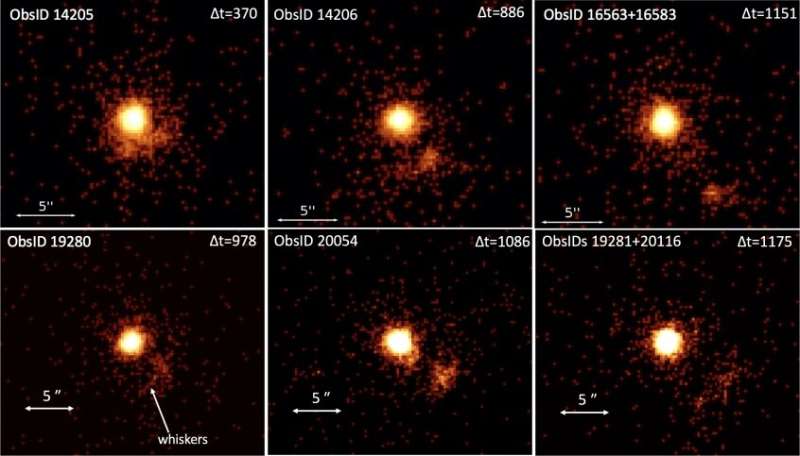Images of the moving clumps from PSR B1259–63/LS 2883 in the binary cycles 2010-2014 (top) and 2014-2017 (bottom). The ∆t values show the number of days since the most recent periastrons. Credit: Pavlov et al., 2019.
Using NASA's Chandra X-ray observatory, astronomers have spotted X-ray-emitting clumps being ejected with high velocities from the gamma-ray binary PSR B1259–63/LS 2883. The findings were presented in a paper published March 2 on arXiv.org, in which the authors also discuss possible explanations of this phenomenon.
Located around 8,800 light-years away in the constellation Crux, PSR B1259–63/LS 2883 is a binary with an orbital period of approximately 3.4 years, composed of a rotation-powered pulsar named PSR B1259-63 and a fast-rotating blue star of spectral type O9.5Ve, designated LS 2883. The pulsar is known for its emission of very high energy (VHE) gamma-rays, which varies on a timescale of several days.
Now, a team of astronomers led by George G. Pavlov of Pennsylvania State University reports the detection of X-ray emission having its source in ejecta from PSR B1259–63/LS 2883. The emission was spotted by Chandra's Advanced CCD Imaging Spectrometer (ACIS) during observations of this system between 2010 and 2017. Images from the space telescope clearly show X-ray-emitting clumps moving from the binary.
"In this work, we describe the main properties of the X-ray emitting ejecta detected in a series of high-resolution Chandra observations during two binary cycles," the astronomers wrote in the paper.
During observations conducted between 2010 and 2014, the scientists have identified a southward extension in the X-ray image of PSR B1259–63/LS 2883 when the binary was close to its apastron. Another clump, apparently moving in the same direction, was spotted during the next binary cycle between 2014 and 2017.
According to the paper, the clumps were moving from the binary with apparent velocities at a level of around 10 percent the speed of light, possibly with a significant acceleration. The research found that the clump detected in the 2010-2014 cycle faded with increasing separation from the binary, while the second clump brightened almost two times in one of the observations.
Trying to find the most plausible explanation for the nature of the clump X-ray emission, Pavlov's team noted that it could be produced by relativistic electrons, likely supplied by the pulsar. They added that in that case, the possible emission mechanisms are synchrotron radiation in the clump's magnetic field and inverse Compton scattering of ultraviolet photons from the luminous high-mass companion off the relativistic electrons. According to the researchers, the collected data favors the synchrotron mechanism scenario.
Furthermore, studying the motion and evolution of the clumps, the astronomers found the lack of any deceleration of these features. This indicates an extremely low density of the ambient medium.
"Such a medium could be created by the pulsar wind, which sweeps out the matter of the stellar wind bubble in a cone confined by the shock that separates the colliding stellar and pulsar winds," the paper reads.
Therefore, the authors of the study concluded that the clumps ejected from PSR B1259–63/LS 2883 are likely composed of a mixture of stellar matter with the shocked pulsar wind, noting that they are formed by the complex interaction of the stellar and pulsar winds.
More information:
George G. Pavlov et al. High-speed Ejecta from the Gamma-ray Binary PSR B1259-63/LS 2883. arXiv:1903.00781 [astro-ph.HE].
arxiv.org/abs/1903.00781
© 2019 Science X Network
























